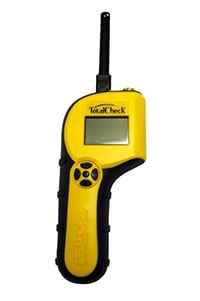Gypsum is a popular material widely used in construction and known for its fire-resistant qualities. One of its more popular construction uses is gypsum wall board, also known as drywall or Sheetrock®. Though the material’s positive attributes outweigh the negatives, gypsum’s limitations are worth discussing.
For example, one issue is that the material is porous — which allows it to readily absorb and be damaged by moisture. Proper management and monitoring of moisture in Gypsum is critical. Both Delmhorst’s BD 2100 and TECH CHECK PLUS have gypsum/drywall scales.
Drying Gypsum Board
Gypsum wall board that has absorbed excessive moisture may be safely dried, but ONLY if drying takes place before mold begins to form. Typically, there is a 24-48 hour window after having been exposed to moisture. However, once mold has begun to form, the contaminated areas must be removed and replaced. This means having the right drywall moisture meter on hand and taking accurate measurements are essential if problems are to be discovered in time to save tainted materials.
Best practices suggest removing a buffer area of about 12 inches surrounding the mold. To ensure safety, however, it's important to know just how far the moisture-compromised area of the board extends.
Testing for Moisture Damage
In some instances, after materials have been safely integrated into a structure, moisture damage can occur. Some of the most common ways this occurs include storm damage and flooding, leaky pipes and/or faulty installation of windows, doors, and flashing.
Sometimes, materials might be damaged to the point where they need to be ripped out rather than restored. Knowing the gypsum’s moisture content can avoid much costlier and more time-consuming problems later. Some moisture testing methods include unscientific tests using sight or smell, as well as more scientific tests with a moisture meter for drywall.
When using a gypsum wall board moisture meter, measuring the moisture content (%MC) of the drywall is simple: just push the pins of the meter into the drywall and take a reading. By removing the pins and inserting them elsewhere to repeat the test in different spots, it's possible to determine just how far the moisture-compromised area extends.
Testing for Moisture UNscientifically
Before using your moisture meter to determine the %MC, you can make some observations using your own senses via your eyes and nose.
Visual Inspection: Drywall that has been compromised by water can appear to be discolored or show signs of deterioration or crumbling. If you’re able to see such damage with your naked eye, there is a chance that the moisture may have spread farther than the eye can see and the area will require a more in-depth inspection with the use of a moisture meter.
Oder Inspection: If you’re able to smell the musty odor of an area suspected of having water damage, then it’s likely there’s major water intrusion. If this is the case, then it’s recommended that you find an expert in mold remediation to address the issue.
Mold is likely to grow in areas with warm temperatures, unsterile conditions, and nearby moisture.
Finding the Right Gypsum Moisture Meter
Acceptable moisture levels vary depending upon the type of material. Therefore, it’s important to use the right moisture meter for your inspection. When testing gypsum board, you’ll want to either use a gypsum moisture meter or use a multi-scale meter that is set to the gypsum scale. Delmhorst’s moisture meter models BD-2100 and TechCheck Plus have scales that are calibrated specifically to gypsum.
 Given the challenging conditions of building inspection, installation and drying jobs, it pays to have a simple, intuitive moisture meter you can depend on—such as Delmhorst’s easy-to-use 2-in-1 TechCheck PLUS, which is calibrated specifically to gypsum.
Given the challenging conditions of building inspection, installation and drying jobs, it pays to have a simple, intuitive moisture meter you can depend on—such as Delmhorst’s easy-to-use 2-in-1 TechCheck PLUS, which is calibrated specifically to gypsum.
For use on drywall, the Delmhorst BD-2100 has a digital display, an adjustable alarm and Delmhorst’s exclusive drywall scale reading mode.
We have found that the equilibrium moisture content (EMC) for gypsum board at 50% RH is 0.3%. Samples exposed to 80-85% RH equalize at 0.4-0.5%. At 90-95%, they equalize at 0.7-0.8% MC.
At these high levels, wood equalizes at about 20%, the generally accepted threshold for wood decay. The actual threshold depends on the length of time the high level of moisture has persisted, the source, and even the type of paint or coating used on the gypsum boards.
The readings the meter provides of up to about 1% on the drywall scale (20% wood) are of most value since a tremendous change in conductivity occurs at around 2%. For all practical purposes, readings above this point are compressed and should be considered more qualitative.
For more help finding the right moisture meter for your job, contact our moisture meter specialists at 877-DELMHORST (335-6467).

Comments